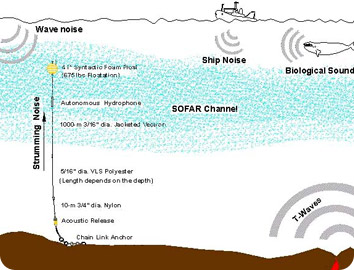We tend to think of the oceans as chambers of silence -- watery cocoons with little or no sound. In reality, though, the oceans are noisy. Fish make sounds to attract mates. Whales send out their beautiful calls. Snapping shrimp “explode” little bubbles of air. Ships and submarines send out pulses of sound. And volcanoes, geysers, and other natural features create sounds of their own.

Sound travels quite well through water. In fact, on average, it travels about five times faster in water than through the air -- close to a mile per second.
Individual sounds can travel for hundreds of miles. That’s particularly true in a sound “channel” that’s about two-thirds of a mile deep. The temperature, pressure, and salinity create conditions that basically trap sounds inside the channel. These sounds have been heard thousands of miles from the point where they were created.
Scientists are using sound to help them study the oceans. They listen for the rumble of volcanoes, and the many sounds of fish. These sounds help them track the fish, teaching them about the habits of many different species.
copyright 2007, The University of Texas Marine Science Institute

